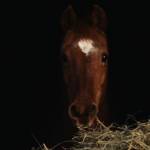Do Horses Go Deaf as They Get Older?

Old age is known to affect hearing in man and many animals, but there has been little research done on this topic in horses. Deafness in equines may be related to old age, congenital factors in Paint horses, or exposure to ototoxic drugs such as gentamicin.
Diagnosing hearing loss in horses can be difficult for several reasons. Traditional behavioral tests of hearing can be subjective and unreliable, whilst a startle reaction test will only reveal severe hearing loss.
Like other animals, deaf horses could compensate by increased use of other senses. Therefore, to accurately diagnose deafness, electrodiagnostic testing is needed, and brain stem auditory evoked response (BAER) is the most accurate test. This measures the response of the vestibulocochlear (eighth cranial) nerve and the auditory centres in the brain stem to sound. The test is performed on sedated horses in stocks. It uses click stimuli of different decibels and the response can be collected using three recording needles placed under the skin of the head.
Researchers at the University of Queensland recorded BAER waveforms in response to click stimuli in five younger (ages 5 to 8 years) and four older (ages 17 to 22) horses. The older horses had significantly diminished responses to the test. This result is consistent with partial deafness in the group, though this condition was not obvious to the handlers of the horses.
Partial deafness should be considered in older horses that show changes in behavioural responses. This test can be used to monitor hearing loss and determine management strategies to cope with partial deafness in horses. The easiest management strategy would be to avoid exposing partially deaf older horses to noisy environments, as these could put the horse or rider/handler at risk of harm.
Reference: Australian Veterinary Journal 2011 89 (3):73.








